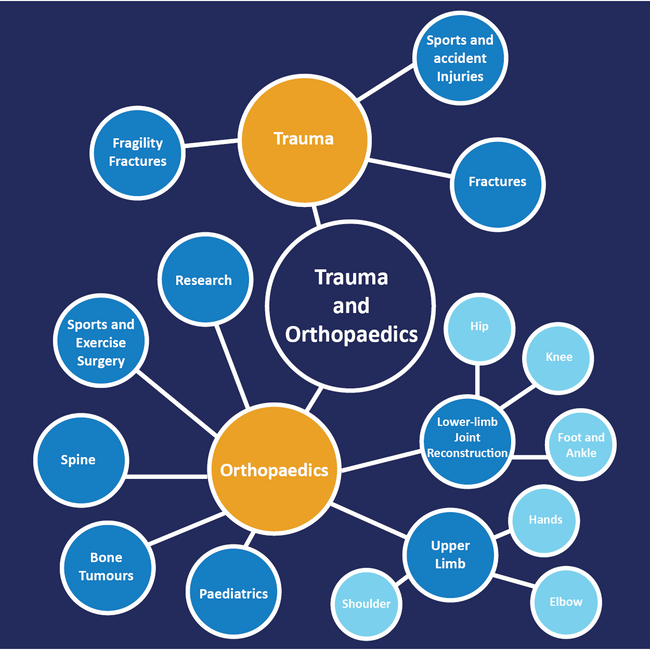Specialties in orthopaedics

Orthopaedic surgeons can specialise in operating on particular parts of the body to repair or correct damage, for example:
- Foot and Ankle – An ankle and foot specialist can focus on ankle arthritis, ankle fractures right through to Achilles tendon ruptures. Surgery will be needed depending on how bad the injury is. For example, for ankle fractures, a surgeon can fix the ankle with plates and screws and can make one or more cuts around the ankle joint. Another example of surgery is for treating arthritis and this includes cleaning out the ankle with key hole surgery. This option may also be suitable in early arthritis, or where a bone is blocking movement. Another option for treating arthritis is to fuse (ankle arthrodesis), the ankle. This means that the bones in the ankle are joined together and this is also performed using keyhole surgery and inserting some screws.
- Hand – there are a number of hand disorders and injuries, which are treated in different ways. Some of these may not require surgery and can be treated using hand therapy. Hand therapy involves using physical methods such as exercise, splinting and wound care. Hand Surgery involves surgery of the hand, the wrist and the peripheral nerves of the upper limb. This also includes reconstructive surgery that improves the upper limb function. Surgery normally involves using fine instruments to handle the structures in the hand. A magnifying glasses maybe used or an operating microscope to help to repair the small nerves and arteries in the hand.
- Hip – there are a number of surgeries patients may have on a hip. A common one is a hip replacement, where a hip joint damaged by arthritis is replaced with a ceramic or metal fitting. This surgery could take up to two hours or more to complete.
- Knee – a knee can have a number of surgeries depending on the injury, such as knee ligament surgery (ACL) to knee replacement surgery. The surgeries can vary in time and recovery for the patient. ACL surgery includes attaching new tissue to the torn ligament from another area from the leg. After having physio therapy the patient will be able to play sports.
- Shoulder and Elbow – Shoulder pain has many different causes and the correct diagnosis is very important to a patient’s recovery. Depending on the cause, the patient may require having elbow and/or shoulder surgery such as elbow replacement surgery or rotator cuff repair shoulder surgery.
- Spine – Orthopaedic spine surgeons often work closely with neurosurgeons who specialise in the parts of the operation involving the nerves and spinal cord. They could be performing surgery to remove tumours to infections. Surgeries include:
- Discectomy: this is a removal of a herniated part of a vertebral disc. This will allow the surgeon to access a swollen nerve and relieve nerve irritation;
- Laminectomy: the bone covering the vertebrae is removed and enlarged to reduce pressure from a stenosis.
There are other specialty areas too, including:
- Reconstruction – Limb reconstruction specialists work with patients that require limb reconstruction for congenital and acquired conditions. Congenital is when a child is born with a limb reduction for example and acquired is when limbs have suffered injuries from trauma, infection or tumours. These problems are improved or corrected by limb reconstruction surgery. Bone transport is one method of filling a bone defect by moving a part of a bone within its soft tissue envelope. This is helpful for dealing with injuries that occur during trauma.
- Paediatrics (Children’s orthopaedics) – the common conditions in children’s orthopaedics are clubfoot, hip dysplasia (ddh) and musculoskeletal infection. An example of a surgery that is involved in children orthopaedics is the Ponseti Method for clubfoot. This involves carefully and gently manipulating and stretching the child’s foot in to a better position. This is then put into a cast.
Find out more about each specialty of orthopaedics on our specialist society page.
